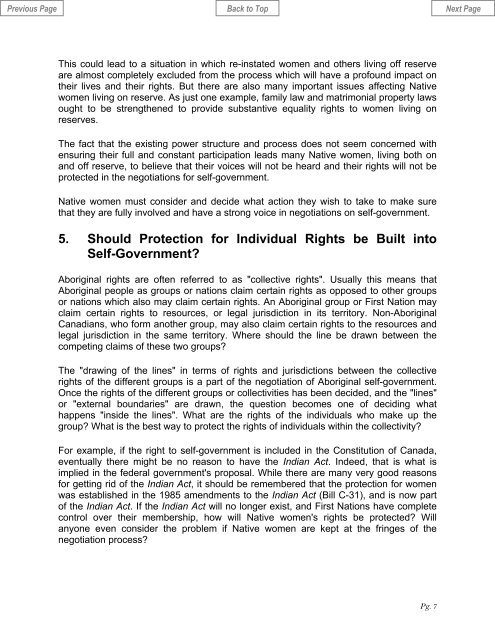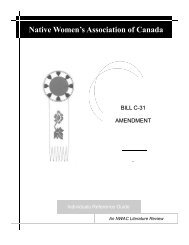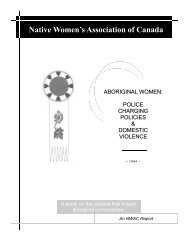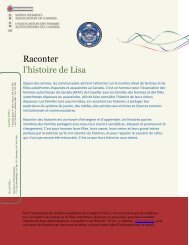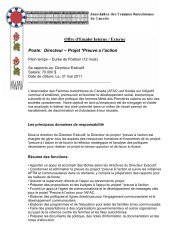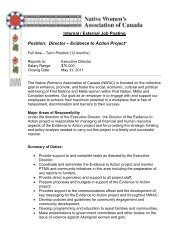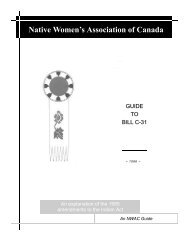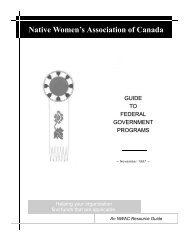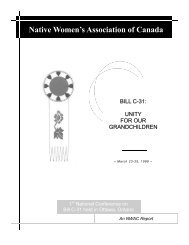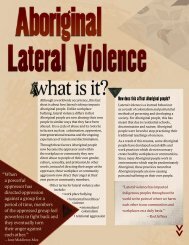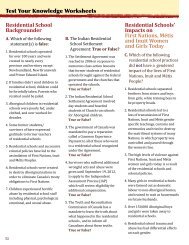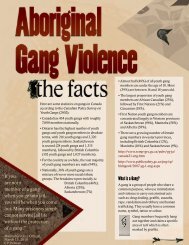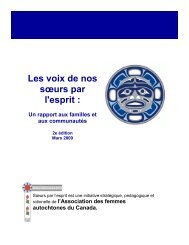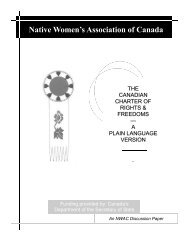Native Women & Self-Government - Native Women's Association of ...
Native Women & Self-Government - Native Women's Association of ...
Native Women & Self-Government - Native Women's Association of ...
You also want an ePaper? Increase the reach of your titles
YUMPU automatically turns print PDFs into web optimized ePapers that Google loves.
This could lead to a situation in which re-instated women and others living <strong>of</strong>f reserveare almost completely excluded from the process which will have a pr<strong>of</strong>ound impact ontheir lives and their rights. But there are also many important issues affecting <strong>Native</strong>women living on reserve. As just one example, family law and matrimonial property lawsought to be strengthened to provide substantive equality rights to women living onreserves.The fact that the existing power structure and process does not seem concerned withensuring their full and constant participation leads many <strong>Native</strong> women, living both onand <strong>of</strong>f reserve, to believe that their voices will not be heard and their rights will not beprotected in the negotiations for self-government.<strong>Native</strong> women must consider and decide what action they wish to take to make surethat they are fully involved and have a strong voice in negotiations on self-government.5. Should Protection for Individual Rights be Built into<strong>Self</strong>-<strong>Government</strong>?Aboriginal rights are <strong>of</strong>ten referred to as "collective rights". Usually this means thatAboriginal people as groups or nations claim certain rights as opposed to other groupsor nations which also may claim certain rights. An Aboriginal group or First Nation mayclaim certain rights to resources, or legal jurisdiction in its territory. Non-AboriginalCanadians, who form another group, may also claim certain rights to the resources andlegal jurisdiction in the same territory. Where should the line be drawn between thecompeting claims <strong>of</strong> these two groups?The "drawing <strong>of</strong> the lines" in terms <strong>of</strong> rights and jurisdictions between the collectiverights <strong>of</strong> the different groups is a part <strong>of</strong> the negotiation <strong>of</strong> Aboriginal self-government.Once the rights <strong>of</strong> the different groups or collectivities has been decided, and the "lines"or "external boundaries" are drawn, the question becomes one <strong>of</strong> deciding whathappens "inside the lines". What are the rights <strong>of</strong> the individuals who make up thegroup? What is the best way to protect the rights <strong>of</strong> individuals within the collectivity?For example, if the right to self-government is included in the Constitution <strong>of</strong> Canada,eventually there might be no reason to have the Indian Act. Indeed, that is what isimplied in the federal government's proposal. While there are many very good reasonsfor getting rid <strong>of</strong> the Indian Act, it should be remembered that the protection for womenwas established in the 1985 amendments to the Indian Act (Bill C-31), and is now part<strong>of</strong> the Indian Act. If the Indian Act will no longer exist, and First Nations have completecontrol over their membership, how will <strong>Native</strong> women's rights be protected? Willanyone even consider the problem if <strong>Native</strong> women are kept at the fringes <strong>of</strong> thenegotiation process?Pg. 7


